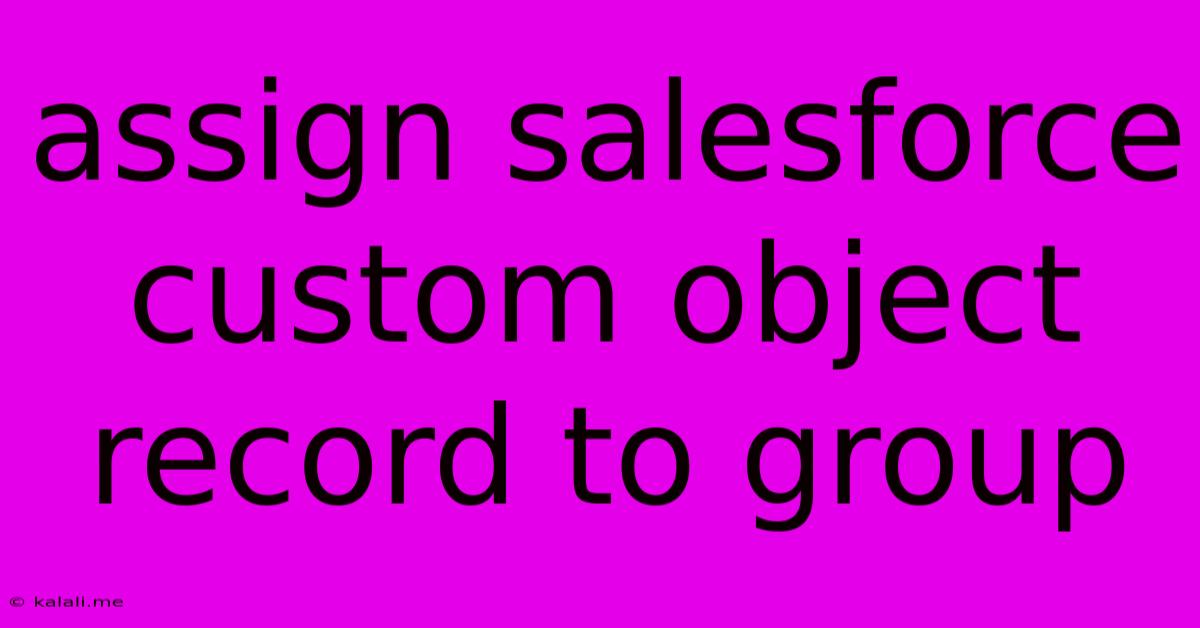Assign Salesforce Custom Object Record To Group
Kalali
May 23, 2025 · 3 min read

Table of Contents
Assigning Salesforce Custom Object Records to Groups: A Comprehensive Guide
Assigning Salesforce custom object records to groups is crucial for efficient team collaboration, streamlined workflows, and improved data management. This comprehensive guide will walk you through the various methods and best practices for achieving this, empowering you to optimize your Salesforce environment. This article covers sharing rules, sharing sets, group ownership, and the considerations for each approach. Understanding these methods will allow you to effectively manage access and collaboration around your custom objects.
Why Assign Custom Object Records to Groups?
Efficiently assigning records to groups offers numerous advantages:
- Improved Team Collaboration: Groups facilitate seamless information sharing and collaboration among team members working on the same records.
- Streamlined Workflows: Assigning records to specific groups automates routing and simplifies processes.
- Enhanced Data Security: Controlling record access through groups strengthens data security by limiting access to authorized personnel only.
- Better Data Management: Organizing records by group enables improved data organization and retrieval.
- Increased Productivity: Reduced time spent searching for information and improved access lead to increased team productivity.
Methods for Assigning Salesforce Custom Object Records to Groups
Several methods allow you to assign custom object records to groups in Salesforce:
1. Sharing Rules:
Sharing rules automatically grant access to records based on criteria you define. You can set rules to share records with specific groups if certain criteria are met (e.g., sharing all records related to a specific account with a sales support group). This is a powerful method for automated access control. However, it requires careful planning and configuration to avoid unintended sharing.
- Strengths: Automated access based on defined criteria, scalable for large datasets.
- Weaknesses: Can become complex to manage with many rules, requires careful consideration to avoid oversharing.
2. Sharing Sets:
Sharing sets allow you to manually add records to specific groups. This provides granular control over which records specific groups can access. This approach is best suited for situations needing more direct, manual control over record access.
- Strengths: Granular control over record access, simple to use for smaller datasets.
- Weaknesses: Less efficient for large datasets, requires manual updates.
3. Ownership:
Directly assigning ownership of the custom object records to a group is not directly supported by standard Salesforce functionality. You typically assign ownership to a user, who is then a member of the desired group. However, carefully designed sharing rules and sharing sets can effectively mimic group ownership by giving the group access to all records owned by its members. This indirect approach leverages existing features to achieve a similar result.
- Strengths: Leverages existing Salesforce features; relatively straightforward to implement.
- Weaknesses: Not a true group ownership; still requires the careful design of sharing rules or sets.
4. Apex Triggers and Workflow Rules (Advanced):
For highly customized solutions, Apex triggers and workflow rules can be used to automatically assign records to groups based on complex logic. This approach demands advanced Salesforce development skills and is only recommended for scenarios requiring intricate automated record assignment based on specific criteria.
- Strengths: Highly customizable and flexible for complex scenarios.
- Weaknesses: Requires advanced development skills, potentially more expensive to implement and maintain.
Best Practices for Assigning Records to Groups
- Clearly Define Group Responsibilities: Establish clear roles and responsibilities for each group to avoid confusion and ensure efficient workflow.
- Regularly Review Sharing Rules and Sets: Ensure your sharing settings remain aligned with your business needs and security requirements.
- Use a Hierarchical Group Structure: If needed, create a hierarchy of groups to manage access more efficiently, reflecting organizational structure.
- Document Your Configuration: Maintain comprehensive documentation of your sharing rules and sets to facilitate future maintenance and troubleshooting.
- Test Thoroughly: Before deploying any sharing changes, thoroughly test them in a sandbox environment to prevent unexpected issues in production.
By understanding and implementing these methods and best practices, you can effectively assign Salesforce custom object records to groups, improving collaboration, security, and overall efficiency within your organization. Remember to choose the method that best suits your specific needs and resources.
Latest Posts
Latest Posts
-
Print Bash Array One Per Line
May 24, 2025
-
How To Fix Paint Ripped Off Wall
May 24, 2025
-
Where Can You Recharge A Fire Extinguisher
May 24, 2025
-
Right Of Way At Two Way Stop Sign
May 24, 2025
-
Can I Shoot 38 Special In A 357 Magnum
May 24, 2025
Related Post
Thank you for visiting our website which covers about Assign Salesforce Custom Object Record To Group . We hope the information provided has been useful to you. Feel free to contact us if you have any questions or need further assistance. See you next time and don't miss to bookmark.